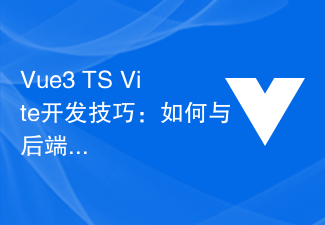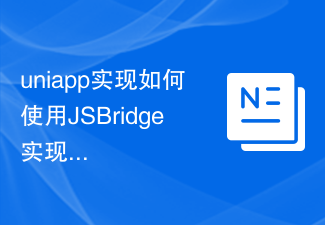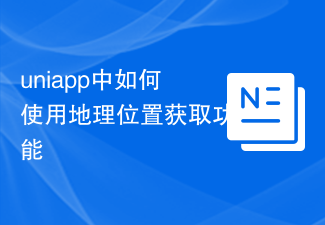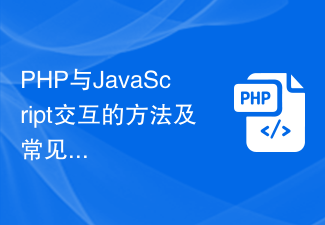
uniapp implements how to use JSBridge to interact with native, requiring specific code examples
1. Background introduction
In mobile application development, sometimes it is necessary Interact with the native environment, such as calling some native functions or obtaining some native data. As a cross-platform mobile application development framework, uniapp provides a convenient way to interact with native devices, using JSBridge to communicate.
JSBridge is a technical solution for the front-end to interact with the mobile native end. By implementing a bridge on the front-end and the native end respectively, the front-end can call native methods and obtain native data. At the same time, the native end can also pass The bridge sends messages to the front end.
2. JSBridge implementation steps
- Create a new js file in the uniapp project and name it JSBridge.js. This file will serve as a bridge between the front-end and native interactions.
- Define a global object in the JSBridge.js file to store messages and callback functions between the front end and native. The sample code is as follows:
// JSBridge.js
let messageHandlers = {}; // 存储前端和原生之间的消息和回调函数
// 注册消息处理函数,前端通过调用此函数来注册对应的回调函数
function registerHandler(name, handler) {
messageHandlers[name] = handler;
}
// 发送消息到原生
function sendMessageToNative(name, data, callback) {
let message = {
name: name,
data: data
};
// 注册回调函数
if (callback) {
let callbackId = 'cb_' + Date.now();
message.callbackId = callbackId;
messageHandlers[callbackId] = callback;
}
// 向原生发送消息
window.webkit.messageHandlers[name].postMessage(message);
}
// 处理原生发送过来的消息
function handleMessageFromNative(message) {
let handler = messageHandlers[message.name];
if (handler) {
handler(message.data, function(response) {
sendMessageToNative(message.callbackId, response); // 发送回调消息给原生
});
}
}
window.messageHandlers = messageHandlers;
window.registerHandler = registerHandler;
window.sendMessageToNative = sendMessageToNative;
window.handleMessageFromNative = handleMessageFromNative;- Introduce JSBridge.js into the
main.jsfile in the uniapp project and register the message processing function. The sample code is as follows:
// main.js
import JSBridge from './JSBridge.js';
// 注册消息处理函数,前端通过调用此函数来注册对应的回调函数
JSBridge.registerHandler('getUserInfo', function(data, callback) {
console.log('前端收到getUserInfo消息:', data);
// 假设需要获取用户信息,可以通过uniapp的API来实现
let userInfo = uni.getUserInfo();
// 返回获取到的用户信息给原生
callback(userInfo);
});
// 假设页面上有一个按钮,点击按钮时调用原生的方法
document.getElementById('btn').addEventListener('click', function() {
// 发送消息到原生
JSBridge.sendMessageToNative('showAlert', { title: 'Hello', message: 'World' });
});- Implement the functions and logic of interacting with the front-end in the native environment. The sample code is as follows:
// 在iOS原生代码中
import WebKit
class ViewController: UIViewController {
var webView: WKWebView!
override func viewDidLoad() {
super.viewDidLoad()
// 创建WebView
webView = WKWebView(frame: CGRect(x: 0, y: 0, width: view.bounds.width, height: view.bounds.height))
view.addSubview(webView)
// 加载uniapp的HTML文件
if let url = Bundle.main.url(forResource: "uniapp", withExtension: "html") {
webView.loadFileURL(url, allowingReadAccessTo: url)
}
// 注册JSBridge处理函数,用于处理前端发送来的消息
webView.configuration.userContentController.add(self, name: "getUserInfo")
webView.configuration.userContentController.add(self, name: "showAlert")
}
}
extension ViewController: WKScriptMessageHandler {
func userContentController(_ userContentController: WKUserContentController, didReceive message: WKScriptMessage) {
if let body = message.body as? [String: Any] {
let name = message.name
if name == "getUserInfo" {
print("原生收到getUserInfo消息:", body)
// TODO: 获取原生的用户信息
// 返回用户信息给前端
let userInfo = [
"name": "John",
"age": 20
]
let response = [
"data": userInfo
]
let javascript = "window.handleMessageFromNative((response))"
webView.evaluateJavaScript(javascript, completionHandler: nil)
}
else if name == "showAlert" {
print("原生收到showAlert消息:", body)
// 假设实现一个弹窗功能
let title = body["title"] as? String ?? ""
let message = body["message"] as? String ?? ""
let alertController = UIAlertController(title: title, message: message, preferredStyle: .alert)
alertController.addAction(UIAlertAction(title: "OK", style: .default, handler: nil))
present(alertController, animated: true, completion: nil)
}
}
}
}3. Use JSBridge for front-end and native interaction
Through the above steps, we have implemented the basic JSBridge bridge and message processing functions. In the front-end code, we can call the JSBridge.sendMessageToNative() method to send messages to the native, and we can also register the corresponding message processing function, such as JSBridge.registerHandler() in the example . In the native code, we register the processing function through the userContentController.add() method to receive the messages sent by the front end and implement the corresponding functions.
In the page, when the button is clicked, call the JSBridge.sendMessageToNative('showAlert', { title: 'Hello', message: 'World' }) method to send the message to the native, After receiving the message natively, a pop-up window with title and content will pop up. In addition, when the front end needs to obtain user information, call the JSBridge.sendMessageToNative('getUserInfo') method to send a message to the native. After the native returns the user information, the front end obtains the data through the callback function and processes it.
To sum up, using JSBridge can easily realize the interaction between uniapp and the native environment, and can implement its own functions and logic in the front end and native respectively. By registering message processing functions, messages can be delivered and processed flexibly.
The above is a brief introduction and code examples about uniapp using JSBridge to realize native interaction. I hope it will be helpful to you.
The above is the detailed content of How does uniapp implementation use JSBridge to interact with native. For more information, please follow other related articles on the PHP Chinese website!
 打开win11的分屏交互方式Dec 25, 2023 pm 03:05 PM
打开win11的分屏交互方式Dec 25, 2023 pm 03:05 PM在win11系统中,我们可以通过打开分屏交互来让多个显示器使用同一款系统,共同操作,但是很多朋友不知道分屏交互怎么开启,其实只要在系统设置中找到显示器就可以了,下面一起来学习一下吧。win11分屏交互怎么打开1、点击开始菜单,找到其中的“设置”2、然后在其中找到“系统”设置。3、进入系统设置后,在左侧选择“显示”4、接着在右边的多显示器中选择“扩展这些显示器”即可。
 手把手教你uniapp和小程序分包(图文)Jul 22, 2022 pm 04:55 PM
手把手教你uniapp和小程序分包(图文)Jul 22, 2022 pm 04:55 PM本篇文章给大家带来了关于uniapp跨域的相关知识,其中介绍了uniapp和小程序分包的相关问题,每个使用分包小程序必定含有一个主包。所谓的主包,即放置默认启动页面/TabBar 页面,以及一些所有分包都需用到公共资源/JS 脚本;而分包则是根据开发者的配置进行划分,希望对大家有帮助。
 Vue3+TS+Vite开发技巧:如何与后端API进行交互Sep 08, 2023 pm 06:01 PM
Vue3+TS+Vite开发技巧:如何与后端API进行交互Sep 08, 2023 pm 06:01 PMVue3+TS+Vite开发技巧:如何与后端API进行交互引言:在网页应用开发中,前端与后端之间的数据交互是一个非常重要的环节。Vue3作为一种流行的前端框架,与后端API进行交互的方式也有很多种。本文将介绍如何使用Vue3+TypeScript+Vite开发环境来与后端API进行交互,并通过代码示例来加深理解。一、使用Axios发送请求Axios是
 uniapp实现如何使用JSBridge实现与原生交互Oct 20, 2023 am 08:44 AM
uniapp实现如何使用JSBridge实现与原生交互Oct 20, 2023 am 08:44 AMuniapp实现如何使用JSBridge实现与原生交互,需要具体代码示例一、背景介绍在移动应用开发中,有时需要与原生环境进行交互,比如调用原生的一些功能或获取原生的一些数据。uniapp作为一种跨平台的移动应用开发框架,提供了一种方便的方式来实现与原生交互,即使用JSBridge进行通信。JSBridge是一种前端与移动原生端进行交互的技术方案,通过在前端和
 uniapp中如何使用地理位置获取功能Jul 04, 2023 am 08:58 AM
uniapp中如何使用地理位置获取功能Jul 04, 2023 am 08:58 AMuniapp是一种基于Vue.js的跨平台开发框架,它可以同时开发微信小程序、App和H5页面。在uniapp中,我们可以通过使用uni-api来访问设备的各种功能,包括地理位置获取功能。本文将介绍在uniapp中如何使用地理位置获取功能,并附上代码示例。首先,在uniapp中使用地理位置获取功能,我们需要在manifest.json文件中申请权限。在man
 UniApp实现性能监控与瓶颈分析的最佳实践Jul 04, 2023 am 08:46 AM
UniApp实现性能监控与瓶颈分析的最佳实践Jul 04, 2023 am 08:46 AMUniApp实现性能监控与瓶颈分析的最佳实践随着移动应用的快速发展,开发人员对应用性能的需求也日益增加。对于UniApp开发者来说,实现性能监控和瓶颈分析是非常重要的一项工作。本文将介绍UniApp中实现性能监控和瓶颈分析的最佳实践,并提供一些代码示例供参考。一、性能监控的重要性在现代移动应用中,用户体验是非常重要的。性能问题会导致应用加载速度慢、卡顿等问题
 PHP与JavaScript交互的方法及常见问题解答Jun 08, 2023 am 11:33 AM
PHP与JavaScript交互的方法及常见问题解答Jun 08, 2023 am 11:33 AMPHP与JavaScript交互的方法及常见问题解答随着互联网的快速发展,网页已经成为人们获取信息、进行交流的主要平台。而PHP和JavaScript是开发网页的两种最常用语言。它们都具有各自的优点和适用场景,而在大型网站的开发过程中,两者的结合将会拓展开发人员的的工作能力。本文将介绍PHP和JavaScript交互的方法及常见问题解答。PHP与JavaSc
 uniapp小程序配置tabbar底部导航栏实战指南Sep 15, 2022 pm 03:33 PM
uniapp小程序配置tabbar底部导航栏实战指南Sep 15, 2022 pm 03:33 PM本篇文章给大家带来了关于uniapp的相关知识,tabBar如果应用是一个多tab应用,可以通过tabBar配置项指定tab栏的表现,以及tab切换时显示的对应页,下面一起来看一下,希望对大家有帮助。


Hot AI Tools

Undresser.AI Undress
AI-powered app for creating realistic nude photos

AI Clothes Remover
Online AI tool for removing clothes from photos.

Undress AI Tool
Undress images for free

Clothoff.io
AI clothes remover

AI Hentai Generator
Generate AI Hentai for free.

Hot Article

Hot Tools

SublimeText3 Mac version
God-level code editing software (SublimeText3)

SAP NetWeaver Server Adapter for Eclipse
Integrate Eclipse with SAP NetWeaver application server.

Atom editor mac version download
The most popular open source editor

mPDF
mPDF is a PHP library that can generate PDF files from UTF-8 encoded HTML. The original author, Ian Back, wrote mPDF to output PDF files "on the fly" from his website and handle different languages. It is slower than original scripts like HTML2FPDF and produces larger files when using Unicode fonts, but supports CSS styles etc. and has a lot of enhancements. Supports almost all languages, including RTL (Arabic and Hebrew) and CJK (Chinese, Japanese and Korean). Supports nested block-level elements (such as P, DIV),

SecLists
SecLists is the ultimate security tester's companion. It is a collection of various types of lists that are frequently used during security assessments, all in one place. SecLists helps make security testing more efficient and productive by conveniently providing all the lists a security tester might need. List types include usernames, passwords, URLs, fuzzing payloads, sensitive data patterns, web shells, and more. The tester can simply pull this repository onto a new test machine and he will have access to every type of list he needs.






